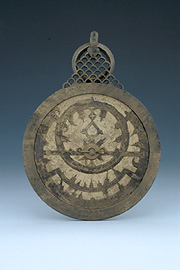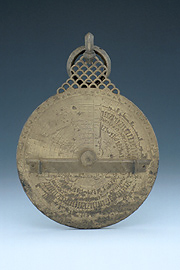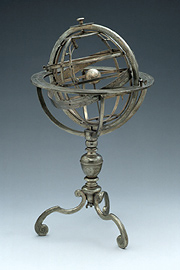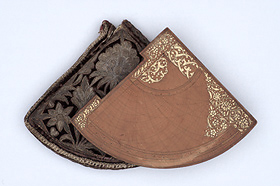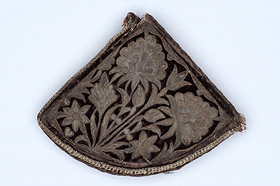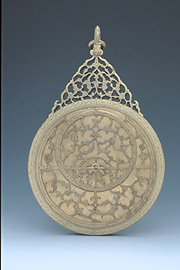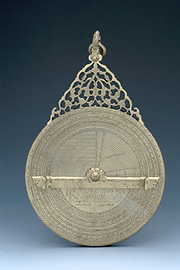|









| |
CLASSICAL
ROOTS AND EARLY ISLAMIC PERIOD
The
real details of the astrolabe�s invention in ancient Greece have largely
been lost. The third century BC mathematician Apollonius, of what is
now Turkey, may have invented its stereographic projection of the celestial
sphere. And the astronomer Hipparchus may have been familiar with that
projection during the next century, or may have even invented the astrolabe
then. A useful but inaccurate Islamic myth is that Ptolemy discovered
the astrolabe when his celestial globe dropped under the hooves of his
donkey. The astrolabe does resemble a celestial globe or armillary sphere
that has been �flattened� into two dimensions. And its basic design
has not changed over the millennia but only been enhanced by many different
features.
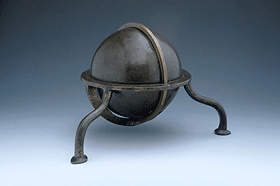 |
Astrolabe
c. 1600
Maker Unknown
England?
Brass
Presented by A.E. Gunther
This astrolabe was first donated to the University in 1659 by
Nicholas Greaves, the brother of John Greaves the Savilian Professor
of Astronomy at Oxford. The rete is similar to that of an astrolabe
signed by the well-known British instrument maker Humfrey Cole,
now at the British Museum. |
Astrolabe,
Persian
984/5 or 1003/4 AD (Dated 374 or 394 A.H.)
Made by Ahamad and Muhammad, Sons of Ibrahim,
Isfahan, Iran
Brass
Lewis Evans Collection
This earliest-known Persian astrolabe is topped by the large triangular
ornament and Kufic script characteristic of its origins. It has
an astrological table on the back with planetary symbols derived
from Greek antiquity. |
Armillary
Sphere, Ptolemaic
1588
Made by Carlo Plato
Rome
Brass
From the Sestieri Collection, Rome
This armillary sphere shows the sun and moon revolving around
a stationary earth, with the moon on a separate orbit. Individual
stars are noted on the rings and pointers. |
ISLAMIC PERIOD
The name “astrolabe” probably comes
from the Arabic version of the Greek term “star holder.”
As early as the fourth century AD, Greek astronomical texts were
being translated into Syriac and Arabic and filtering into the
Islamic world. The astronomer Nastulus, of what is now Iraq, made
the earliest surviving astrolabe circa 927/8. Islamic astrolabes
are unique in the degree to which they assist the religion founded
by the Prophet Muhammad in the seventh century AD. Their features
include tools for judicial astrology, for determining the five
or more prayer times of each day, and for finding the direction
of Mecca.
|
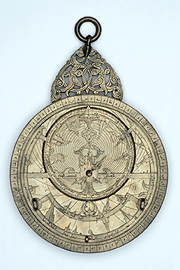 |
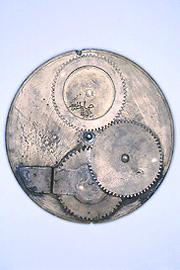 |
Astrolabe
with geared calendar
1221/2 (dated 618 A.H.)
Made by Muhammad, born Abi Bakr
Isfahan, Iran
Brass and Silver
Lewis Evans Collection
This is the oldest complete, geared machine in existence. Moving
the astrolabe’s rete moves the gears on the back. This reveals
the lunar phase, the lunar date, and the positions of the sun
and moon through three apertures in the mater. |
Astrolabe
Quadrant
1682/3 (dated 1094 A.H.)
Made by Ahmad al-Ayyûbî'
Turkey
Lacquered Wood
This Prophatius style astrolabe quadrant also has an horary quadrant
for telling time. The two projections on its side are sights.
The back features a trigonometric graph. |
Astrolabe
1634/5
Made by Qa’im Muhammad
Lahore, Pakistan
Brass
Lewis Evans Collection
This astrolabe’s rete depicts 50 stars, and the mater features
a gazetteer of the longitudes and latitudes of 120 locations.
The back includes an astrological table of the planets, and unusual
scales of the Syrian solar months and the 28 mansions of the moon. |
EUROPEAN PERIOD
In the eighth century AD, the Islamic world extended
into Spain. It was from there that Greek and Islamic texts on
the astrolabe were translated into Latin and reintroduced into
Europe. Hermann “the Lame” wrote of the instrument in
the 11th century, as did Chaucer at the end of the 14th century.
At about the same time as Chaucer, Jean Fusoris of Paris established
the fist known commercial instrument workshop in Europe. European
makers rediscovered and improved older Islamic designs and added
their own stylistic hallmarks. For example, the retes on Flemish
astrolabes like that on this shelf by Arsenius, mimic tulips.
Soon the astrolabe was being produced for all types of astronomy,
navigation and surveying. But other instruments began to replace
it in Europe in the 17th century, and later in some parts of the
Islamic world.
|
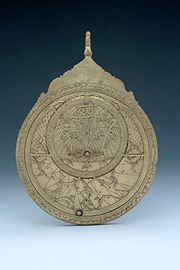 |
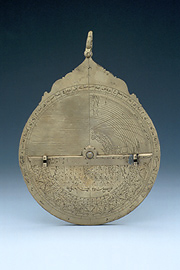 |
Astrolabe
1682
Made by Qassim 'Ali Qa'inbi
Persia
Brass
Billmeir Collection. Formally in the Chadenat Collection
The basmalah - “In the name of Allah, the compassionate,
the merciful” - has been incorporated into this rete’s
ecliptic circle. The bird on the rete represents the “falling
vulture” star, Alpha Lyræ. The mater is engraved with
a gazetteer indicating the longitude, latitude, and distance from
Mecca of almost 40 cities and towns. |
|


